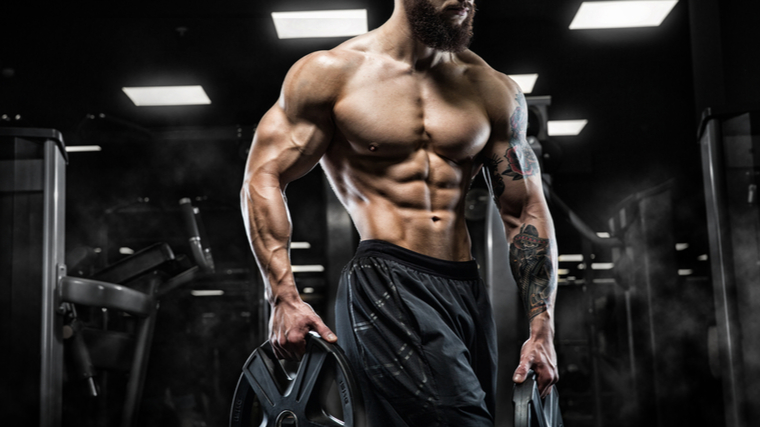A good physique is awe-inspiring. Everyone has their own reasons for picking up their first barbell, but the goals are mostly universal. Whether you want to look good, feel better, or lift the heaviest weights, you have to hit the ground running and start your fitness journey strong.

Fortunately, there’s a lot of good information out there on how to eat right, train properly, and recover optimally. We’re going to compile it all right here for you to reference. This is your Beginner Bible for Bodybuilding.
How to Train Bodybuilding as a Beginner
If you’re a fresh-faced trainee who just signed up for their first gym membership (or purchased some home equipment), it is totally normal to feel intimidated. Before you learn the ins and outs of training, the gym can be a scary place, and nobody likes making a fool of themselves.
Luckily, we can steer away from any potential mishaps by outlining the core principles of bodybuilding training for the neophyte gymgoer.
Prioritize Technique
For rank beginners, lifting is as much a technical skill as it is a means to an end. While bodybuilding movements aren’t always as complex as the sumo deadlift or clean & jerk, you still need to learn the proverbial ropes before you’re able to start progressing.
Think of it this way. If the exercises you perform are the means by which you grow muscle, a sloppy performance would therefore lead to sloppy gains. Taking extra time to make sure your form is correct will set you up for long-term success in the gym.
Find the Right Exercises
In strength sports like powerlifting or weightlifting, athletes have certain movements they must practice in order to perform. However, bodybuilding is far less constrained. The goal of bodybuilding is to train your muscles, not to train a specific movement pattern.
So, while there are some exercises that get a lot of bang for their buck, remember that bodybuilding moves are simply tools in your toolbox. If you don’t enjoy the back squat, that’s perfectly fine — there are dozens of other options for training your quads.
When you’re getting started in the gym, experiment with many different exercises to find what suits your body.
Go Slow and Steady
The old adage, “slow and steady wins the race,” is as true in bodybuilding as it is in marathon running. In your first few years of exercise, progress will come quickly, so there’s no reason to rush.
Seeing someone squat 400 pounds “ass to grass” in the gym should be motivating, but don’t make the mistake of assuming there’s a shortcut to that level of strength — or size. Adding too much weight (or volume, the amount of work you perform) too soon can at best stall your progress and at worst contribute to or even potentially cause an injury.
Train Every Muscle
This might sound obvious, but since bodybuilders are judged on every aspect of their physiques, it must be said. Nobody neglects the “mirror muscles” — there’s a reason Monday is commonly known as “International Chest Day.”
But some new lifters make the mistake of not showing any love to the smaller muscles or the ones on their backsides. A big chest and capped shoulders are all well and good, but many veteran physique athletes will say that bodybuilding shows are won from the back.

[Read More: Our Favorite Forearm Workouts, + the Best Forearm Exercises]
Your calves, hamstrings, glutes, lats, and rear delts all deserve as much — if not more — love as you show to your biceps.
Beginner Bodybuilding Program
Since bodybuilding is so individualized, it may seem counterproductive to follow a pre-written program. However, if you’re new to the gym, taking the guesswork out of training can be a blessing.
Instead of falling prey to paralysis by analysis, keeping up with a pre-written template can let you focus on what matters most — working hard and putting on size.
The Program
Most bodybuilding routines are broken up into “splits” that dedicate certain days to specific muscles. This makes perfect sense for athletes with a few years of training under their belt who may need to pay attention to the details of their physiques.
Newer lifters can get more out of less. A three-or-four day program focused on compound exercises (moves that involve more than one joint) can stimulate lots of muscle growth at one time without requiring you to be in the gym for three hours every day.
Day 1: Upper Body
- Bench Press: 3 x 6
- Dumbbell Flye: 2 x 8
- Dumbbell Row: 3 x 6
- Face Pull: 2 x 12
- Lateral Raise: 2 x 12
Day 2: Lower Body
- Box Squat: 3 x 6
- Romanian Deadlift: 3 x 8
- Step-Up: 2 x 12
- Good Morning: 2 x 12
- Calf Raise: 2 x 12
Day 3: Full Body
- Deadlift: 3 x 5
- Overhead Press: 3 x 6
- Incline Dumbbell Press: 3 x 8
- Upright Row: 2 x 8
- Cable Crunch: 2 x 10
Day 4: Arms, Abs, Calves
- Barbell Curl: 3 x 8
- Hammer Curl: 2 x 8
- Skull Crusher: 3 x 8
- Plank: 3 sets for 30 seconds
- Side Bend: 2 x 10
- Calf Raise: 2 x 10
Note: One of the most common forms of exercise notation, shown above, is (sets) x (reps).
You can perform this workout throughout the week however you like, though it is probably best to not train three days in a row. Days 1 through 4 could be split up across the week on Monday, Tuesday, Thursday, and Friday.
How to Eat For Bodybuilding
When it comes to gaining lean mass, perhaps the only thing more important than the right approach to training is having adequate nutrition. The right diet can help you make gains faster, recover more quickly, and feel better overall.

Luckily, nutrition for bodybuilding is mostly the opposite of training — it is straightforward, quantifiable, with a distinct set of rules and principles that apply to basically everyone.
Caloric Intake
Calories are the fuel source your body utilizes to do everything from regulate brain function to contracting your muscles. While the science of nutrition can be incredibly complex, in broad terms, the nature of caloric intake is simple.
To gain muscle, you must consume more calories than your body spends. If there aren’t excess calories present, you have nothing to grow new muscle tissue with.
Conversely, to burn fat, you must consume fewer calories than you burn. Your body has no reason to tap into its energy reserves if you’re already providing more calories than it needs to function.
To figure out how many calories you need requires a serious understanding of nutritional science, a command of mathematics, and a comprehensive grasp of human physiology. Or, a solid calorie calculator that does the work for you:
Calorie Calculator
Macronutrients
Macronutrient is a fancy term for protein, carbohydrates, and fat. Your macros are inextricably linked to your calories, as each macronutrient has a different caloric value. Your total caloric intake is made up of a composition of your macronutrients — the challenge is getting them in the correct proportions.
- Protein has four calories per gram and is primarily responsible for the growth, repair, and maintenance of tissues in the body, including and especially muscle tissue.
- Carbohydrates also have four calories per gram. Carbs fuel activity of all kinds, from leisurely walking to high-intensity lifting. They also play a role in healthy brain function.
- Fats have nine calories per gram and are essential for bodily regulation. They help to level out internal processes, maintain hormone balance, and create a feeling of satiety after eating.
To find out how to juggle your macronutrient intake so you’re always primed for muscle growth, you can utilize our macro calculator:
Macronutrient Calculator
Supplements and Recovery
The bodybuilding industry is rife with advertisements for nutritional supplements. While a good pre-workout can fire you up in the gym, remember that supplements aren’t meant to be the centerpiece of your diet or recovery.
Bodybuilding Supplements for Beginners
If you’re new to the gym, your nutritional supplementation should probably match your training style — lean, focused, and effective. Many products promise quick gains and fast progress on the label, but knowing what is worthwhile can save you time and money down the road.
While you can (and should, when possible) get all your nutritional needs from whole-food sources, including these cornerstone supplements is a smart choice if you want to optimize your fitness game:
- Protein Powder
- Creatine
- Pre-Workout Powder
- Multivitamin
- Fish Oil
There are a wide array of other options to stock your supplement cabinet with, but these five are reliable, consistent, and have extensive research backing their legitimacy.
Recovery for Beginners
To make gains in the gym, you have to train as hard as you can. But you need to recover even harder than that. The core idea of bodybuilding is muscular damage. Your muscle tissues are challenged, damaged, and then built back up stronger and bigger than before.
Optimizing your recovery involves managing stress levels, ensuring your nutrition is sufficient and getting lots of high-quality sleep. If you’re crushing it in the gym but slacking at home, don’t be surprised if your progress is dampened or halted altogether.
While you’re finding your footing in the gym, take at least three rest days per week. Resistance training is a very aggressive stimulus on the body, especially when you’re not adapted to it, so it is best to err on the side of caution and be generous with your days off.
[Read More: Best Tasting Protein Powders, Tested and Reviewed by Our Team]
The Complete Picture
Bodybuilding is addictive. You might find that a passing inclination to put on a bit more muscle evolves into an all-consuming passion for fitness and physical improvement. Fortunately, bodybuilding is also an area where you are rewarded proportionally to the effort you put in.
If you’re anxious to get started on your physique journey, everything you need to know is here for you to draw from. With the right program, some hearty nutrition, and — most importantly — enough motivation, you’ll be growing new muscle before you know it.
Featured Image: Lebedev Roman Olegovich / Shutterstock